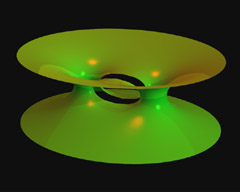|
|
Touching Soap Films |
|
|
|
Handles and Tunnels
Out of crystallography there sprang also an enrichment of the theory of minimal surfaces: the Marburg crystallographers Elke Koch and Werner Fischer have given an account of Plateau problems for piecewise linear boundary curves made from segments of rotation axis of crystallographic groups. The solutions of these problems yield embedded infinite surfaces analogous to the one shown in Fig 8. A very flexible method for the construction of new minimal surfaces - unlike that illustrated in the case of the catenoid in Fig 14 - is based on the fact that triply periodic minimal surfaces can be made more complicated by the construction of 'handles' (or 'tunnels'). This method succeeds especially easily with surfaces that meet all the face planes of the crystallographic building blocks in closed planar lines of curvature and therefore have waists in these planes (Fig 23). The construction of a handle is a continuous process, in which the length of the handle must be chosen so that the additional symmetry planes associated with the handle coincide with symmetry planes already present in the surface. Each new handle unfortunately renders uncertain the accommodation of the lengths of all of the handles already present in the surface, so that the required expenditure of effort depends strongly on the complexity of the cell. Furthermore it is unknown whether still more complicated examples exist or whether-after a few steps-one has reached a surface in which no further handles can be constructed. This situation is similar to the situation that Richard Schoen's theorem described for the catenoid. Until now, of course, there have been no impossibility theorems of this kind for triply periodic minimal surfaces, and also no examples have been discovered that hint at such theorems. |
